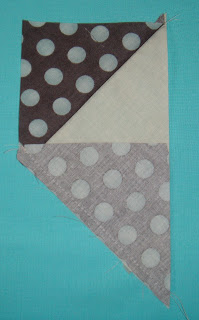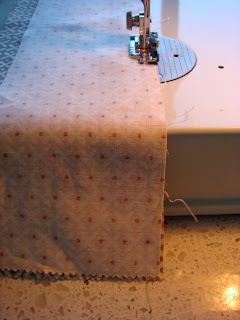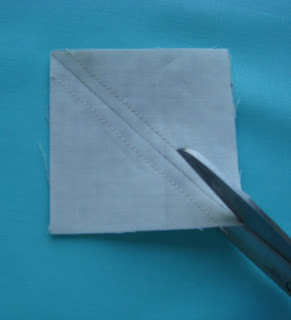Tuesday, May 1, 2012
On Vacation
Sorry about not having the next block up. I am preparing to go on vacation and things have been pretty hectic around here. I hope to have the block posted nest week!
Sunday, March 11, 2012
KANSAS CITY STAR envelope motif
Here we go with Kansas City Star! It is called the envelope motif because the points of the star are not as visible. The cutting directions are a little different so that you get experience reading another popular way it is done on patterns. You will be cutting squares, the then cutting those into triangles. In this particular pattern the squares are cut in half diagonally. Some patterns will have you cutting them like an x so you end up with four triangles. Good luck!
1. Cut out your pieces. Notice the diagram on how to cut some squares into half triangles.
2. With right sides together, stitch B triangles to square A in order shown in photos.
Press seams as you go!
Press towards the dark throughout construction.
3. Lay out the entire block and then proceed to sew the sections illustrated.
4. Take E Triangle and stitch C triangle right sides together.
Do this for all 4 “C” triangles.
Press as you go.
Remember this is a stretch seam because you are sewing on the bias. Go gently as to not stretch it out of shape.
5. Stitch E and F triangles together.
6.Lay out the entire block once again and sew into 3 units as shown.
Now sew those 3 units together and you are done!
Saturday, February 11, 2012
PINWHEEL
In this block we will see another way to get a great result without much sewing on the bias. We will stitch strips of fabric together, and then cut out the triangle with the aid of a template. The various pieces are given a letter to help. Make your own little key with your chosen fabrics. Have fun!
Trace and cut out templates on plastic. You need to be able to see through it.
Decide and be aware of what fabric is placed where.
Cut: Fabric A: 12” x 4”
Fabric B: 12” x 4”
Fabric C: 12” x 3”
Fabric D: 12” x 3”
Pair up the strips as shown.
Sew long sides together.
Press Unit AC seam toward darkest fabric.
Press Unit DB seam the opposite way.
Align templates and trace 4 AC and 4 BD --
AC is done with Left Template
BD is done with Right Template
Cut out as shown.
Lay out pieces to form pinwheel.
**STITCHING HINTS**
-place tip of triangle where needle is
-hold both threads as you sew and gently pull back
-stitch slowly and with fingertips, keep seam allowance at 1/4”, especially as you reach the end of the triangle.
-sausage stitch all 4 sections this helps too.
Hard part is over!
Stitch square sections together. Make sure you press your seams so they face opposite directions.
Stitch middle seam and you are done!
Friday, January 13, 2012
FLYING GEESE
Flying geese is a classic block that looks easy but can be hard! Traditionally you sew two small triangles to a larger one. The technique I am using helps you avoid stretching the seam while sewing on the bias. We will use a rectangle and two squares. It wastes a bit of fabric, but you will like the results.
This is an overview of how the geese are made. The steps are pictured and described below.
Cut 24 2”x 2” squares of background fabric.
Cut 12 2”x 3 1/2” rectangles of various fabrics.
On the back of the 24 squares draw a diagonal line from corner to corner.. Place the fabric on a cutting mat; it helps to provide traction.
Place one square on a rectangle, right sides together. Stitch on diagonal.
Sew all 12 one after another (sausage stitching). Trim seam allowance to 1/4”.
Press seam toward darker fabric.
Place square at other end of rectangle, right sides together, so diagonals form a point. Stitch on diagonal.
You will end up with 12 geese.
Make 2 strips of geese by sewing one strip of 8 geese (12.5x3.5")
and one strip of 4 geese (6.5x3.5").
If your edges seem a bit wonky when the blocks are finished–don't worry and DO NOT trim them. They will look straight and fine when all of the blocks are sewn together.
Friday, November 11, 2011
Churn Dash
This is an easy block that looks hard. Remember to press as you go and plan ahead which way you will press the seams so they alternate. Have fun. And.... send us some photos of your creations!
A - Cut 1 - 1 1/2” x 12’ background fabric
B - Cut 1 - 1 1/2” x 12”
C - Cut 1 - 2 1/2” x 2 1/2”
D - Cut 2 - 2 7/8” x 2 7/8”
E - Cut 2 - 2 7/8” x 2 7/8” background fabric
Pair Strip A and Stirp B right sides together.
Sew along the longest edge.
Press seam towards darkest fabric (B).
Line up sides on mat and cut end so square.
Cut AB strip into 2 1/2” x 2 1/2” pieces.
Take the two “E” squares.
Place them wrong side up on cutting mat.
Draw 1 line diagonally from corner to corner.
The cutting board helps to hold the fabric still.
Pair D and E right sides together. (2 sets)
Stitch 1/4” on either side of the pencil line.
Cut on the pencil line.
Open and press to darker fabric.
Clip “dog ears.”
You now have 4 triangle squares.
Lay out all pieces to form the block.
Stitch into 3 strips and press as shown.
Seam direction should alternate.
The pieces lock to form perfect intersec.tions.
Stitch strips together.
Press.
Done!
Your finished block should measure 6 1/2 inches square.
Friday, October 14, 2011
nine patch
9 PATCH is our second block. It consists of 2 blocks that you can see if you scroll to the bottom of this entry. I chose to use many fabrics to make my block. It will look striking in alternating 2 fabrics or alternating high contrast light and dark. I hope Lisa will post hers and Marci (hint hint!) so you can see some variations. Also, a monochromatic look would be nice. PLEASE post some photos on Flicker. You can also leave a question in the comments and I will be happy to answer and help out. Happy piecing!
Cut 18 1 1/2”x 6” pieces
Sew together in sets of 3
You will end up with at least 6 strip sets
Press 3 sets with seams in
Press 3 sets with seams out
Cut crosswise 1 1/2”
You will end up with 18 pieced sets
Arrange into 5 groups of 3 as desired
(There are more pieced sets than needed)
TAKE A PHOTO NOW FOR REFERENCE
Seams should be pressed to alternate. This helps to match seams nicely when stitching.
Press each seam as you go
Stitch 9 patches together
9Patch (a) has 3 blocks
9Patch (b) has 2 blocks
Subscribe to:
Comments (Atom)

























































